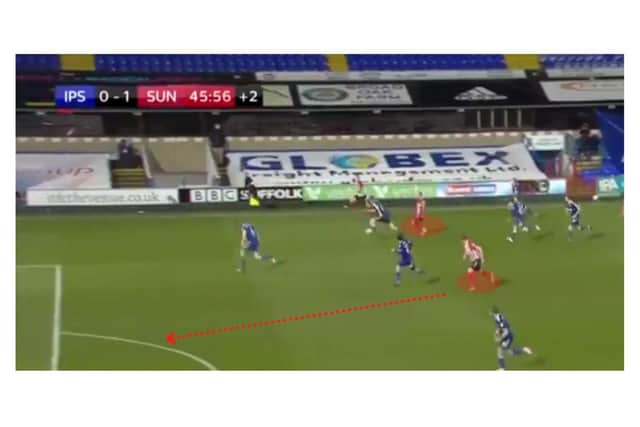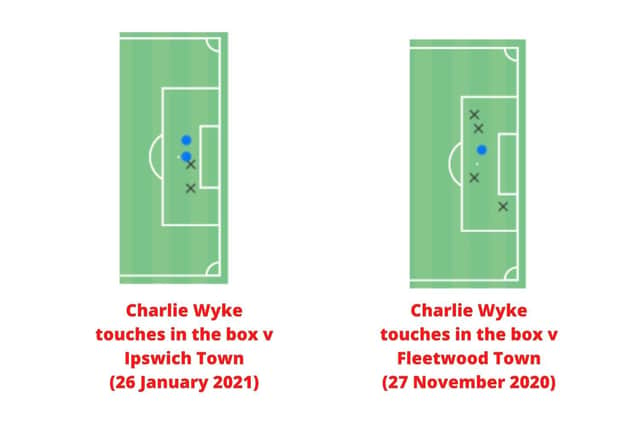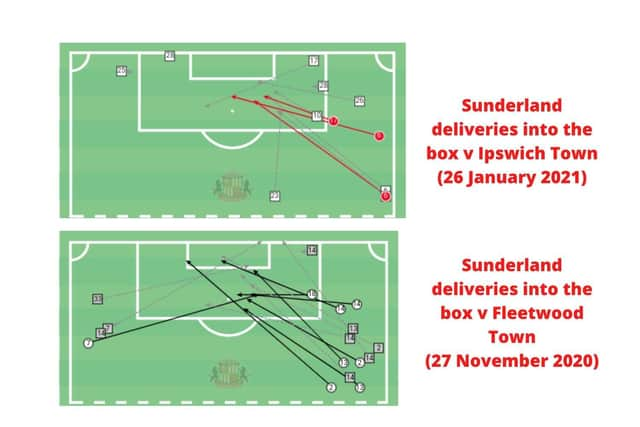Inside Charlie Wyke's remarkable Sunderland run and the tactical changes that unlocked his best form
and live on Freeview channel 276
The Black Cats were struggling for goals on the whole and while some form of attacking reinforcements were also going to be targeted during January, supporters craved an out-and-out goalscorer.
But now, as we approach the final days of the window, Sunderland find themselves in possession of one of the most in-form strikers in England.
Advertisement
Hide AdAdvertisement
Hide AdWith seven goals in seven league games, Charlie Wyke has started to attract the headlines – with his impressive form of late continuing as he netted the winner at Ipswich Town on Tuesday.


That took his tally in League One this season to 12, more than the last two campaigns combined, and with half of the league campaign still to play you would back the frontman to increase that figure.
So how has he managed to hit the goal trail in such impressive fashion, and what are the secrets behind Wyke’s form of late?
We take an in-depth look at how the striker has shot to prominence in recent weeks:
A TACTICAL SWITCH


Advertisement
Hide AdAdvertisement
Hide AdWyke has been a major beneficiary of Sunderland’s change in both approach and shape.
While Lee Johnson has alternated between shapes during his time in charge, he has largely opted for a 4-2-2-2 – with Wyke partnered by Aiden O’Brien.
That partnership has allowed Wyke to redefine his game and focus less on holding up play and running the channels and focus instead on getting into the box.
Indeed, even when playing as the central striker in a 4-3-3 – as we saw in the first-half at Ipswich Town last night – Wyke isn’t being dragged out wide as much as he was under the previous regime.


Advertisement
Hide AdAdvertisement
Hide AdThe perfect example came when Sunderland scored at Portman Road. After Carl Winchester’s clever flick, Aiden O’Brien picked up the mantle and created an overload on the right flank with Max Power. That allowed Wyke to drive into the area – and gave Power the option of an early cross, which was well-executed.
Under the previous management, Wyke was often left to pursue these causes out wide himself – meaning that when crossing positions were established, there was often no option in the box given that the striker had been pulled out to the flanks.
Now, he’s taking up far better areas and is reaping the rewards.
ALL ABOUT AREAS


A quick glance at the data shows that Wyke is getting into far better positions than he was earlier in the season.
Advertisement
Hide AdAdvertisement
Hide AdHis touches in the box have actually decreased under the new regime, albeit only marginally (Wyke averaged 4.5 touches in the box under Parkinson, compared to 4.43 under Johnson – but that first figure is slightly skewed by the dominant performance over Aston Villa under-21s earlier this term).
But it’s where those touches are coming in the box that is proving crucial.
Often deployed as a typical target man under Parkinson, the striker was often left with his back to goal – meaning his touches in the box generally came towards the edge of the area, meaning he struggled to have a real impact on goal.
That’s far from the case now.
All four of Wyke’s touches in the box against Ipswich Town came within eight yards of goal, as Sunderland sought to get the ball to the striker in areas where he could test the goalkeeper.
Advertisement
Hide AdAdvertisement
Hide AdThat was far from the case earlier in the campaign. Take Parkinson’s final game in charge, the 1-1 draw at Fleetwood Town, as an example – where Wyke touched the ball five times in the box – but the vast majority of those touches were from further than 12 yards out.
The Black Cats are now finding the striker in far better areas in the box, and it’s no surprise to see his xG per shot rise as a result.
LESS DELIVERIES – BUT MORE QUALITY
With Wyke taking up better areas in the area, it was crucial that Sunderland started to put balls into the box – and just any delivery, but the right delivery.
Parkinson often pointed to the fact his side were among the leading sides in the division for deliveries into the box, but that’s ultimately a redundant statistic if those crosses lead to nothing.
Advertisement
Hide AdAdvertisement
Hide AdIt was a scattergun approach, with crosses thrown into the area from all angles in the hope something would drop.
Now, we see something more resembling a coherent plan.
Sunderland’s number of crosses has unsurprisingly decreased since Parkinson’s exit, with the Black Cats now averaging 19 deliveries into the box per game under Johnson – compared to 23.76 prior to his arrival.
But the quality of those deliveries, and the area they are coming from, is much improved under the new regime
We’re seeing a high proportion of crosses come from within 18 yards of the goal and an even higher proportion come from and into the POMO ( the position of maximum opportunity, or the area close to the byline and in and around both posts, for those unfamiliar with Johnson’s lexicon).
Advertisement
Hide AdAdvertisement
Hide AdWhile there is still work to be done in this department – the accuracy of Sunderland’s deliveries has dipped of late, for example - a more coherent strategy when it comes to getting the ball into the area is certainly helping Wyke.
The deliveries are into the right area, and the striker himself is getting into those areas.
It sounds simple, but it can often be a tricky thing to master in football. For now though, Wyke and Sunderland seem to have found the right formula.
AN ARM AROUND THE SHOULDER
There are also some less tangible qualities at play here, too.
Advertisement
Hide AdAdvertisement
Hide AdFor all tactical changes, taking up better areas and improving your deliveries into those areas are key components, you need a striker full of confidence to tie all those components together and put the ball in the back of the net.
And in Charlie Wyke, Sunderland certainly have that.
It’s easy to forget that Wyke was actually out of the team in the early weeks of Johnson’s reign. An injury meant he missed the early defeat to Wigan and only featured as a substitute in some of the head coach’s early games.
In his absence, Will Grigg was handed an opportunity – and there were some promising signs, even if goals didn’t flow.
But behind the scenes, Johnson was confident that Wyke would be the man to flourish in his system
Advertisement
Hide AdAdvertisement
Hide AdHe made no secret of his admiration for the striker and told Wyke as much, putting a hypothetical arm around the shoulder during the early weeks of his tenure – at what could have been a concerning time for the striker.
From there, confidence grew – with the striker recently having admitted that he has never felt such belief in his abilities since arriving on Wearside.
And if there’s one stat that highlights Wyke’s new-found confidence, it’s this one: the striker has had 11 shots on target since Johnson was appointed as head coach, and seven of them have yielded goals.
Maintain that kind of ratio, and Wyke could well fire Sunderland up the League One table in the second half of the season.